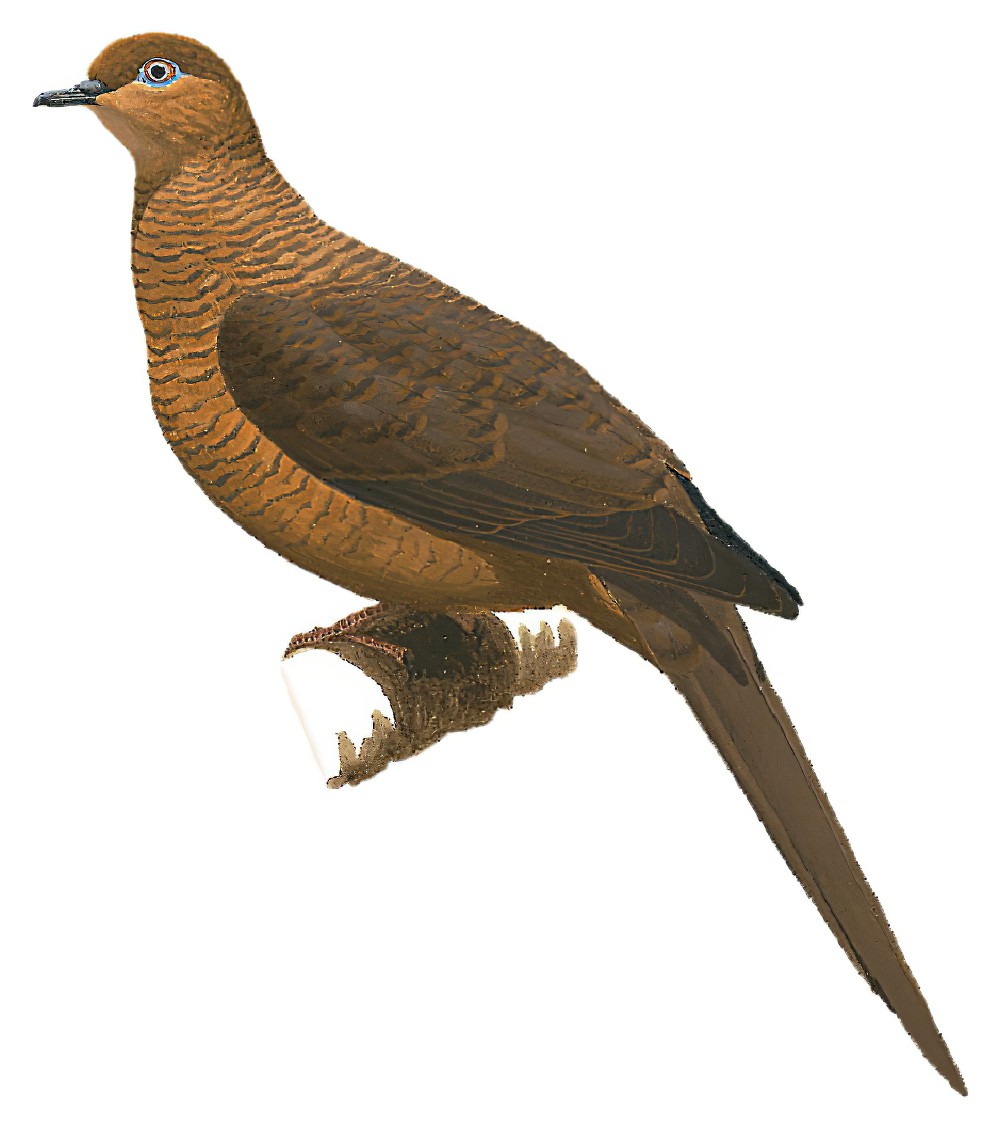Timor Cuckoo-Dove / Macropygia magna

Timor Cuckoo-Dove
SCI Name:
Protonym: Macropygia magna Proc.Zool.Soc.London(1863) (1863), Pt3 p.497
Taxonomy: Columbiformes / Columbidae / Macropygia
Taxonomy Code: timcud1
Type Locality: Timor.
Author: Wallace
Publish Year: 1864
IUCN Status: Least Concern
DEFINITIONS
MACROPYGIA
(Columbidae; Ϯ Philippine Cuckoo Dove M. tenuirostris) Gr. μακρος makros deep; -πυγιος -pugios -rumped < πυγη pugē rump; "Macropygia, Sw. Wings moderate, rounded; the first and second quills graduated, and much shorter than the third. Tail long, graduated; the feathers very broad and obtuse. The rump feathers very thick set. Bill short: the gonys angulated. Tarsus plumed. Hinder toe longer than the tarsus. M. phasianella. Pl. Col. 100. Reinwardii. Ib. 248. infuscata. Lich. (Brazil.)" (Swainson 1837); "Macropygia Swainson, Classif. Bds., 2, 1837, p. 348. Type, by subsequent designation, Columba phasianella Temminck, 1824, pl. col. 100. (not Columba phasianella Temminck 1821) = Macropygia tenuirostris Bonaparte (Salvadori, Orn. Pap. e Mol., 3, 1882, p. 132).1 ... 1 Gray mentions two species in 1840 and again in 1841 without designating a type; in 1855 he designates amboinensis which was not one of the originally included species. Strangely enough neither Bonaparte nor Reichenbach actually designated a type." (Peters 1937, III, 75).
Var. Hacropygia.
Synon. Coccyzura, Tusalia.
magna
L. magnus great, large, mighty.
● ex “Grand Promérops de la nouvelle Guinée” of d’Aubenton 1765-1781, pl. 639, and Sonnerat 1776, “Grand Promérops à paremens frisés” of de Buffon 1770-1783, and “Grand Promerops” of Latham 1782 (syn. Epimachus fastuosus).
● ex “Tangara des grands bois de Cayenne” of d’Aubenton 1765-1781, pl. 205, “Grand Tangara” of de Buffon 1770-1783, and “Grand Tanager” of Latham 1783 (syn. Saltator maximus).
● "93. ALAUDA. ... magna. 9. A. subtus flava, fascia pectorali curva nigra: rectricibus tribus lateralibus albis. Alauda magna. Catesb. car. 1. p. 33. t. 33. Habitat in America, Africa. Corpus scolopacinum, magnitudine Turdi, totum subtus flavissimum. Pectus macula magna nigricante lunari. Remiges fuscæ: secundariæ testaceo maculatæ. Cauda rotundata: Rectrices 3 laterales maximam partem albæ. Unguis posticus pedum major, sed magis curvus quam in reliquis. Rostrum rectum: Maxilla superior teretiuscula, basi nuda." (Linnaeus 1758) (Sturnella).
● ex “Grand Traquet” of de Buffon 1770-1783, and “Dark Warbler” of Latham 1783 (unident.).
UPPERCASE: current genus
Uppercase first letter: generic synonym
● and ● See: generic homonyms
lowercase: species and subspecies
●: early names, variants, mispellings
‡: extinct
†: type species
Gr.: ancient Greek
L.: Latin
<: derived from
syn: synonym of
/: separates historical and modern geographic names
ex: based on
TL: type locality
OD: original diagnosis (genus) or original description (species)












